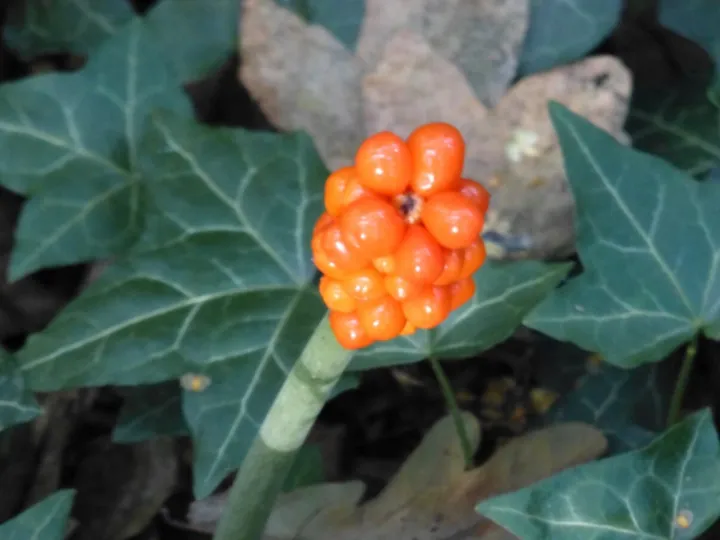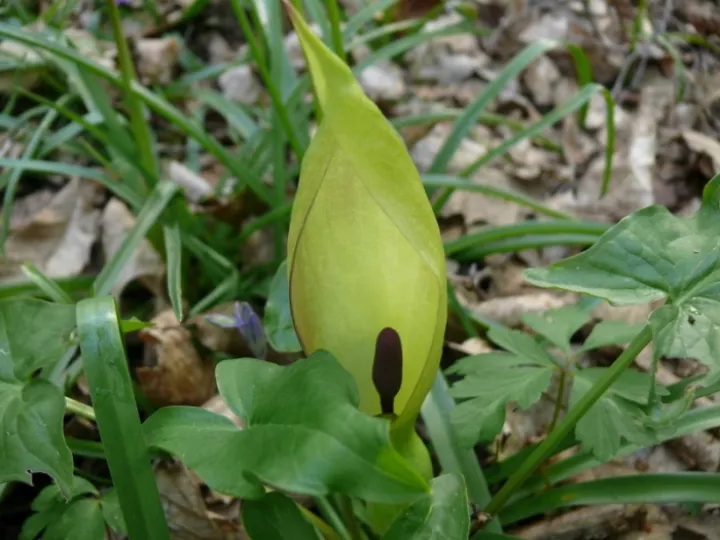Tarvin Community Woodland – Wild Arum
Wild Arum – Arum maculatum
This is the time of year to notice in the woodland small stalks bearing berries that started off green but then mature through orange to a spectacularly bright red – the very poisonous fruit of the Wild Arum. Known by the widest variety of names of any British plant (including Cuckoo Pint, Lords and Ladies and Jack in the Pulpit – to give some of the less-bawdy ones), the Wild Arum is a plant with a very ingenious method of pollination.
Perhaps, though, we should first mention that all parts of Wild Arum are poisonous. The berries are particularly bad but all parts of the plant contain sap that burns and blisters. Because it hurts the mouth, there are very few serious poisonings – the first reaction is to spit it out. It often grows among Wild Garlic and, when young, the leaves are very similar. If you enjoy foraging for wild garlic, smell is the safe way to distinguish the two. Don't try tasting!
What we might consider to be the flower is actually an elaborate and highly effective fly trap. What we see is a curved, pale green spathe or hood – a structure very much like a loose cone made from a sheet of paper. In the centre is the visible part of the flower – a dark spike, called the spadix, which down below within the spathe bears the "working parts" of the flower, hidden away in the body of the spathe. The purpose of the top of the spadix is to emit a smell to attract flies and other insects. It is said that it is also able to emit heat and can raise the local temperature by as much as 15 degrees centigrade, which the flies seem to like.
The Spathe is slippery and the flies fall down into the body of the spathe, which then serves to entrap the insects once they have been drawn in. At the base of the spadix and totally enclosed by the spathe are three different parts of the "true" flower. At the top of the trap, at the narrowest part of the spathe, there is a cluster of hairs derived from sterile male filaments. Their purpose is simply to block the escape of the flies – when the plant has finished with them, these hairs will wither and release the flies to take pollen to another Arum, which, in turn will entrap them and use them in just the same way.
The important seed-producing female parts sit right at the bottom of the trap, welcoming the flies, which they hope are carrying fresh Arum pollen from another plant. The pollen being brushed on the stigmas of these ovules, they will be fertilised and develop into the spike of berries that remain when the spathe and the rest of the spadix have withered.
Between the hairs at the top and the female ovules at the bottom lie the pollen-producing male stamens. Once the female ovules have been pollinated, the male stamens will release a dusting of pollen over the flies, the hairs above will wither and the flies will be released from the trap to find another Arum to pollinate. Now the leaves and the spathe will wither and die, so that all that remains will be the pollinated ovules on their stem. These will grow to be the fruit that we see on the spike, starting off green and, by August, ripening into a stick of bright red berries. Interestingly, while these are poisonous to humans, they can be eaten by foraging birds without ill effect!
The wild Arum seems to have had very little commercial value – especially recently. In 1440, the nuns of Syon Abbey (near the site of today's Syon House) used the roots of the cuckoo-pint flower to make starch for altar cloths and other church linens. In fact, at that time, communion linen could only be prepared in this way. It is reported that the root of the cuckoo-pint, when roasted well, is edible and, when ground, was once traded under the name of Portland sago. It was used (like salep or orchid flour) to make saloop – a drink that was popular before the introduction of tea or coffee. It was also used as a substitute for arrowroot. However, if prepared incorrectly, it can be highly toxic. Caution is advised! I think that the best thing to do with these interesting plants is just to watch them at a distance as they go through their cycle of growth each year!
Quick Links
Get In Touch
TarvinOnline is powered by our active community.
Please send us your news and views.









